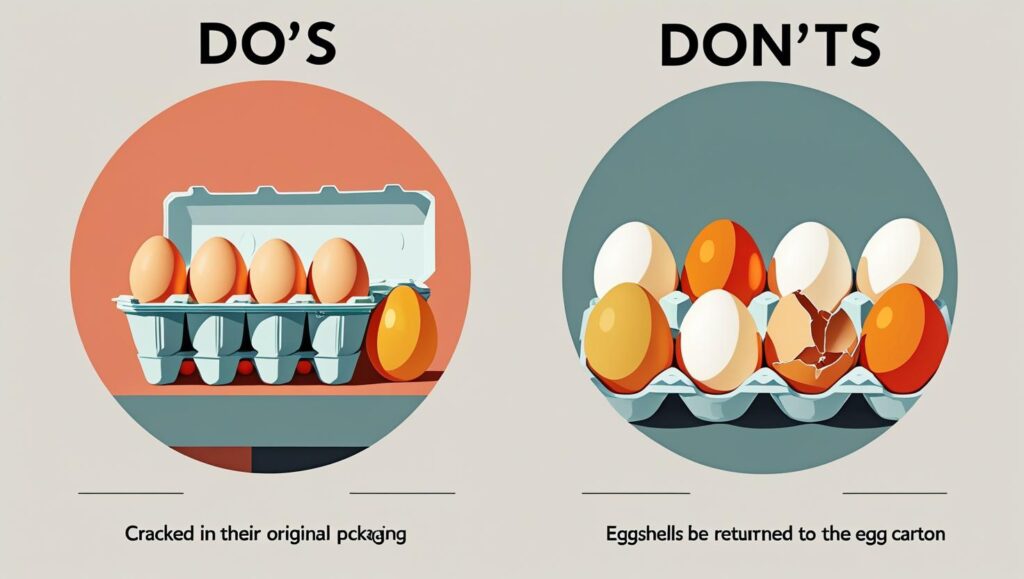It’s a common habit in kitchens worldwide: cracking an egg and placing the empty shell back into the carton. While it may seem like a tidy shortcut, food safety officials and microbiologists warn this simple act could pose a significant health risk due to potential Eggshell Cross-Contamination. The practice greatly increases the chance of transferring harmful bacteria, such as Salmonella, from a used shell to the remaining fresh eggs, the carton, and your hands.
The Science of Cross-Contamination
The primary concern is the transfer of pathogens. Eggshells can become contaminated with bacteria in two primary ways. Vertical transmission occurs inside the hen, infecting the egg’s contents before the shell is formed. More commonly, horizontal transmission happens after the egg is laid, where bacteria from the hen’s feces or the nesting environment contaminate the shell’s exterior.
“Bacteria can be present on the outside of an eggshell because it exits the hen’s body through the same passageway as feces,” explains a guidance document from India’s Food Safety and Standard Authority (FSSAI).
Even commercially cleaned eggs are not entirely without risk. In the United States, the U.S. Department of Agriculture (USDA) requires eggs to be washed and sanitized to reduce surface contamination. This process, however, also removes the egg’s natural protective layer, called the cuticle, making the shell more porous. In contrast, most European Union countries prohibit egg washing, relying on the intact cuticle to act as a defense barrier.
Regardless of the method, once you handle an egg and crack it, any bacteria on its surface can transfer to your hands, the countertop, and the broken shell itself. Placing that shell back into the carton creates a direct pathway for contamination.
“Storing fresh eggs and eggshells together greatly increases the risk of bacteria transfer by hands, utensils, [and] air,” the Egg Safety Center, a food safety information resource, stated in a public advisory. This act can contaminate the shells of the remaining eggs, which you might later handle before they are cooked.
Why Reusing Egg Cartons is Also a Hazard
The risk extends beyond just the shells. Both the Food and Drug Administration (FDA) and the USDA advise against the reuse of egg cartons for the same reason: they are considered one-time-use packaging.
“Bacteria from foods that these packages once contained may remain on the packaging and thus be able to contaminate foods or even hands if reused,” the USDA’s Food Safety and Inspection Service (FSIS) warns.
The material of the carton plays a role in this risk.
- Pulp/Cardboard Cartons: These are porous and can absorb moisture and bacteria from a leaking or contaminated egg. A 2021 study in the Journal of Applied Poultry Research noted that the micropores in pulp could trap microorganisms, but also found that once damp, these cartons offer less protection.
- Plastic and Foam Cartons: While less absorbent, these materials can still harbor bacteria on their surfaces. They cannot be effectively cleaned and sanitized at home to ensure they are safe for reuse with fresh eggs.
For those who purchase eggs from local farms or have backyard flocks, the advice is to collect eggs in a clean, washable container, like a wire basket, and to use new cartons for storage and distribution.

The Salmonella Threat: Low Prevalence, High Impact
Salmonella is the pathogen most commonly associated with eggs. The Centers for Disease Control and Prevention (CDC) estimates that about one in every 20,000 eggs is contaminated with the bacteria. While the odds are low for any single egg, the consequences of infection can be severe.
Symptoms of salmonellosis include diarrhea, fever, and stomach cramps, typically appearing 6 hours to 6 days after infection. While most people recover without treatment, the illness can be serious, and sometimes fatal, for young children, older adults, and individuals with weakened immune systems.
The FDA’s Egg Safety Rule requires producers with 3,000 or more laying hens to implement measures to prevent Salmonella contamination. These measures, combined with refrigeration and safe handling, are critical lines of defense.
“To prevent illness from bacteria: keep eggs refrigerated, cook eggs until yolks are firm, and cook foods containing eggs thoroughly,” reads the mandatory safe handling statement on egg cartons in the U.S.
Global Best Practices for Egg Safety
To minimize the risk of cross-contamination and foodborne illness, food safety authorities worldwide offer consistent advice:
- Discard Shells Immediately: After cracking an egg, dispose of the shell in a compost bin or trash can. Do not place it back in the carton or on a food preparation surface.
- Wash Hands Thoroughly: Always wash your hands with soap and water after handling raw eggs or used shells.
- Keep Cartons Clean: Do not reuse egg cartons. Recycle paper cartons and dispose of foam or plastic ones according to local guidelines.
- Inspect Before Buying: Open egg cartons at the store to ensure eggs are clean and none are cracked. Bacteria can enter through even hairline cracks in the shell.
- Refrigerate Promptly: Store eggs in their original carton in the main body of the refrigerator at a temperature of 40°F (4°C) or below. Avoid storing them in the refrigerator door, where temperatures fluctuate.
- Cook Thoroughly: Cook eggs until both the yolk and white are firm. Dishes containing eggs should reach an internal temperature of 160°F (71°C).
By treating eggshells and their packaging as potential sources of contamination, consumers can take a simple yet effective step in ensuring the safety of their kitchens. The habit of returning a shell to its carton is one that, according to experts, is worth breaking for the sake of health.


 How Quick Air Fryer Meals Are Reshaping the American Kitchen
How Quick Air Fryer Meals Are Reshaping the American Kitchen A Depression-Era Staple, Southern Tomato Gravy, Finds New Life in Modern Kitchens
A Depression-Era Staple, Southern Tomato Gravy, Finds New Life in Modern Kitchens Why a Forgotten 1950s Cake with a Secret Ingredient Is Trending Again
Why a Forgotten 1950s Cake with a Secret Ingredient Is Trending Again More Than a Dessert: How Tar Heel Pie Captures the Essence of North Carolina
More Than a Dessert: How Tar Heel Pie Captures the Essence of North Carolina